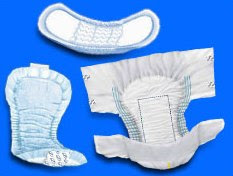According to the National Association for Continence, roughly 6.5 million Americans suffer from fecal incontinence and approximately 25 million Americans experience urinary incontinence. Studies found that a staggering two-thirds of those people who experience symptoms of urinary incontinence do not use any treatment or product to manage the condition. Oftentimes this is due to the general lack of knowledge about available options. Thanks to dependable home health care centers there are a wide range of hospital quality products and support that are easily accessible.
There are many different incontinence supplies available for every unique situation. Products are offered in four distinct styles with a wide variety of protection range, as well as overnight absorbency. The choice depends on the level of incontinence (INCT), desired comfort, convenience or one's mental and/or physical condition. Someone who is seated or lying down for most of the time will require a different type of protection than a person who is still fairly active. Using the right product will help reduce leakages, lower product consumption and increase overall comfort.
A discreet bladder control pad is specifically designed for mild to moderate absorbency. These can come either with or without plastic and are often individually wrapped. Pads are designed with adhesive strips that will secure them to the user’s regular underwear.
Protective underwear is designed to be worn in place of regular underwear. Often called "pull ups" as they pull up and down for ease of use. They are made with soft, breathable materials that promote security, comfort and dignity. Protective underwear is currently offered in gender specific products, as are bladder control pads. Both styles provide mild to moderate INCT control.
Another incontinence product style is the liner pad, which is designed for moderate to maximum INCT production. These provide larger coverage yet a discreet, close body fit when worn with specifically designed reusable pants or one's own underwear.
Traditional briefs, also known as adult diapers, are typically a convenient choice for those experiencing large amounts of urine or fecal loss. The one-piece design offers maximum coverage and protection for complete bladder and/or bowel control.
Another category of incontinence products is the bladder control underpad. These are used on chairs, beds and wheelchairs to protect the mattress or fabric from any accidents or leakage. Underpads can be especially useful for physically or mentally incapacitated persons who may be seated for long periods of time or cannot express to the caregiver when there is an incontinence issue. These come as either disposable or reusable. Disposable underpads are convenient while the reusable ones are cost-efficient. The choice depends on each person’s needs.
Thanks to specialty home health care centers there are INCT support and savings programs available to those managing incontinence. To help ease the emotional discomfort there are discreet home delivery programs available and discount pricing plans. These programs allow for products to be delivered in a discreet manner so as not to suggest what they are. Scheduling convenient delivery prevents customers from running out of product each month and offers maximum savings.
Understanding the multiple choices and programs can be overwhelming. INCT Specialists are available to help determine which questions need answering in order to assess each person’s needs. Often they are available not only in-stores but also through toll free numbers or online. They can also offer free, try-before-you-buy samples for personal evaluations. Remember, no matter the situation there is an incontinence product or program that will suit each person’s needs; it’s simply a matter of having the facts.
About Binson's:
Today there are Binson's Home Health Care Center retail outlets in both Michigan and Florida that offer continuously updated products and services. For more information about incontinence products and programs call Binson’s at 888-246-7667 and ask for the IP Program, or visit: http://www.binsons.com
